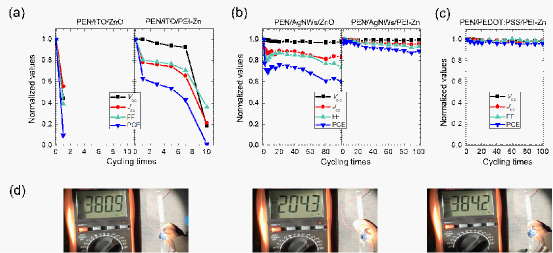Flexible electronics have extensive prospects in biological/medical sensing, wearable electronics, and other emerging fields. To ensure such devices’ continuous detection, the matched power supply with flexibility and stretchability is urgently needed. Based on organic polymer materials, organic photovoltaics have natural advantages in mechanical flexibility compared with crystalline silicon, cadmium telluride, and other semiconductors. However, the mechanical durability of the cells during the continuous deformation cycling at a micrometer-scale bending radius is still challenging. To obtain good mechanical robustness, all the functional layers (including electrodes, interlayers, and the active layer) are required to have good mechanical flexibility.
Recently, Professor Yinhua Zhou’s group at Wuhan National Laboratory for Optoelectronics, Huazhong University of Science and Technology, developed a Metal ion-chelated polymer interfacial layer. Begun with polymer cathode interface layer polyethyleneimine (PEI), they adopted zinc ion to chelate with the amine in PEI (donated as PEI-Zn), obtaining an electron transporting layer with excellent photoelectric properties and mechanical flexibility. On 1.3 μm polyethylene naphthalate (PEN) substrates, ultraflexible inverted non-fullerene solar cells with the PEI-Zn interlayer display a power conversion efficiency of 12.3% on PEDOT:PSS electrodes and 15.0% on AgNWs electrodes.

Figure 1 (a) Device structure of the ultrathin solar cells and Pictures of the fabricated ultrathin solar cells; (b) J-V characteristics of the ultrathin devices with conducting polymer (PEDOT:PSS) or Ag nanowires as the transparent electrodes.
Zhou's group has found that high-performance non-fullerene acceptors tend to react with PEI (Adv. Mater. 2019, 31, 1806616. J. Mater. Chem. A 2018, 6, 2273.) in their earlier researches. The chelation of Zn2+ with the PEI reduces the chemical reactivity of PEI, and therefore the reaction between the PEI and the non-fullerene active layer is suppressed. The molar ratio of Zn2+-to-N is optimized to obtain the best recipe for non-fullerene solar cells. The ultrathin solar cells demonstrate excellent performance when the ratio of Zn2+-to-N is more than 4:1. Moreover, PEI-Zn inherits the good flexibility of PEI, which can endure a maximum bending strain over twice as high as that of ZnO. After the bending test, there are no cracks on the surface of PEI-Zn, while several cracks could be observed on the surface of ZnO.

Figure 2 (a) J-V characteristics of the devices with PEI-Zn ETL containing different Zn-to-N mole ratios; (b) Absorption spectra of three solutions: IT-4F, IT-4F mixed with PEI, and IT-4F mixed with PEI-Zn solution; (c) N 1s x-ray photoelectron spectroscopy of the PEI-Zn films containing different Zn-to-N ratios: (d) Flexibility of PEI-Zn and ZnO.
After achieving the ultrathin organic solar cells, Zhou's group measured the mechanical flexibility of devices through combining with the pre-stretch elastomer. The results indicated that the devices based on PEI-Zn with different electrodes (ITO, AgNWs, and PEDOT:PSS) showed better flexibility than those on ZnO interfacial layer. When PEDOT:PSS was used as bottom electrodes, the ultraflexible cells show nearly unchanged power conversion efficiency during 100 continuous compression-flat deformation cycles with a compression ratio of 45%. In the end, the ultraflexible cell is demonstrated to be attached to the finger joint and displays reversible current output during the finger bending-spreading.

Figure 3 Evolution of photovoltaic parameters after different compressed-flat cycles of ultraflexible of cells with different electrode/ETL: (a) with PEN/ITO/ZnO and PEN/ITO/PEI-Zn; (b) with PEN/AgNWs/ZnO and PEN/AgNWs/PEI-Zn; (c) with PEN/PEDOT:PSS/PEI-Zn; (d) Pictures captured from the supplementary videos to demonstrate the current recovery during the cycling: cell attached on a finger joint.
Zhou's group illustrated that PEI-Zn has excellent photoelectric properties, chemical stability, and mechanical flexibility. Meanwhile, this electron transporting layer is compatible with AgNWs and PEDOT:PSS electrodes and different active layers including PBDB-T-2F:IT-4F and PBDB-T-2F:Y6, which can be very promising in printed electronics and flexible electronics.
This work is reported on Nature Communication named "Robust metal ion-chelated polymer interfacial layer for ultraflexible non-fullerene organic solar cells" (Nature Communication, 2020, 11, 4508. https://doi.org/10.1038/s41467-020-18373-0). Fei Qin, Wen Wang, and Sun lulu at Wuhan National Laboratory for Optoelectronics are the co-first authors. Prof. Yinhua Zhou lead this work. Prof. Jianhui Hou at Institute of Chemistry, Chinese Academy of Sciences, Prof. Takao Someya at The University of Tokyo, and Dr. Kenjiro Fukuda at RIKEN also contributed to this work.